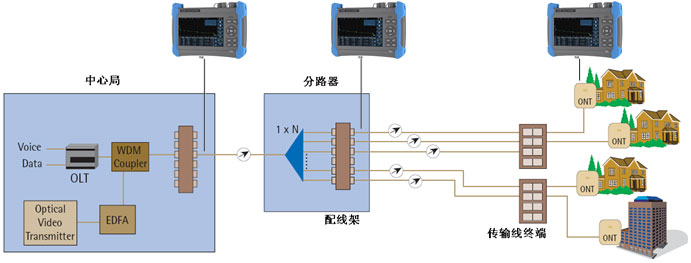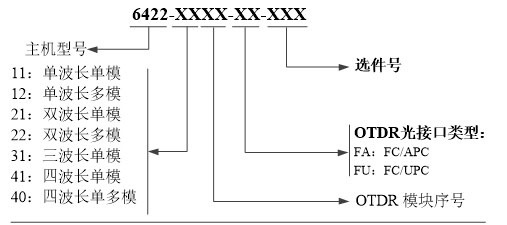Shandong Fengtu IOT Technology Co., Ltd
Sales Manager:Ms. Emily Wang
Cel,Whatsapp,Wechat:+86 15898932201
Email:info@fengtutec.com
Add:No. 155 Optoelectronic Industry Accelerator, Gaoxin District, Weifang, Shandong, China

Sales Manager:Ms. Emily Wang
Cel,Whatsapp,Wechat:+86 15898932201
Email:info@fengtutec.com
Add:No. 155 Optoelectronic Industry Accelerator, Gaoxin District, Weifang, Shandong, China

Model:6422-4001
Brand:fengtu
1. Multi-function optical fiber fault tester product overview
multi-function optical fiber fault tester is used to measure the length, loss, and connection quality of various optical fibers and cables.6422multi-function optical fiber fault tester has the ability to test single-mode 1310nm, 1550nm, 1490nm, 1625nm, 1650nm, multi-mode 850nm, 1300nm and customized special wavelengths. It can provide a variety of modules such as single wavelength, multi-wavelength, online testing, etc. The maximum dynamic range is 46dB, which can be used for long-distance multi-branch communication network testing of trunk lines; the minimum event blind area is 0.8m, and the connection status of the near end can be clearly distinguished; the maximum sampling resolution is 2.5cm, which can accurately locate the event point. In addition, it provides a variety of convenient functional options such as stable light source, optical power meter, visible red light source, fiber end face inspection instrument, WiFi module, etc.
2. Main features of multi-function optical fiber fault tester
Maximum 46dB dynamic range, 256k data sampling points;
PON network online testing function;
Single-mode and multi-mode integrated testing function;
Communication light automatic monitoring function;
Supports Bellcore GR196 and SR-4731 file formats.
1. Fast and automatic testing
The automatic test function of 6422 makes it unnecessary for users to know more details about the operation of the instrument. The test steps become very simple. Users only need to connect the optical fiber to the corresponding OTDR port of the product and click the [Test] button. The instrument will automatically set the corresponding test conditions and give the final test results, including test curves and event lists.
2. Unique PON network testing function
6422 is a test instrument for fiber access network and FTTx, with built-in PON network test function. It can test each branch of PON network through up to 1:128 optical splitters.
3. Automatic light detection and alarm function
When the OTDR tests a fiber link, if there is a communication optical signal in the fiber, the test result will be inaccurate, and even the detector inside the instrument will be irreversibly damaged. The 6422 has the function of automatically monitoring the communication optical signal in the tested fiber. As long as the tested fiber is connected to the optical interface of the 6422, it will automatically sense and monitor whether there is a communication optical signal in the fiber during the test phase. Once an optical signal is detected, an alarm message will be prompted in time to provide timely protection for the instrument.
4. Intelligent graphic display function of optical fiber link events
Select the analysis mode switch button to perform a graphical analysis of the current trajectory curve and display the graphical analysis interface.
5. Fiber end face inspection function
The instrument is equipped with an optional end face detection function. Click the [End Face Detection] button to enter the end face detection operation interface.
3. Typical applications of multi-function optical fiber fault tester

4. Technical Specifications of Multi-function Optical Fiber Fault Tester
| Maximum dynamic range | For details, please refer to "6422 OTDR Standard Module Technical Specifications" |
| Ranging accuracy | ±(0.75+distance×0.0025%+sampling interval)m, ignoring refractive index error |
| Distance measurement resolution | 0.025, 0.05, 0.1, 0.2, 0.5, 1, 2, 4, 8, 16, 32m |
| Test range | 0.4, 0.8, 1.6, 3.2, 6.4, 16, 32, 64, 128, 256, 512km (single mode); 0.4, 0.8, 1.6, 3.2, 6.4, 16, 32km (850nm multimode) |
| Test pulse width | 3, 5, 10, 30, 80, 160, 320, 640, 1280, 5120, 10240, 20480ns (single mode); 3, 5, 10, 30, 80, 160, 320, 640, 1280ns (850nm multimode) |
| Maximum number of sampling points | 256k |
| Linearity | 0.03dB/dB |
| Loss resolution | 0.001dB |
| Refractive index setting range | 1.00000~1.99999 (step 0.00001) |
| Distance Units | Kilometers, meters, thousand feet, feet |
| show | 800×480, 7-inch TFT color LCD (with capacitive touch screen as standard) |
| Optical output interface | FC/UPC (standard, LC/UPC, SC/UPC, ST/UPC, FC/APC optional) |
| Interface language | Optional Simplified Chinese, English (other languages can be customized) |
| External Interface | USB, Micro-USB, 10M/100M Ethernet, Micro SD |
| power supply | AC/DC adapter: AC100V~240V, 50/60Hz, 1.5A; DC: 15V±2V(2A); Internal lithium battery: 10.8V, battery working time: 8 hours |
| Maximum power consumption | 10W (non-charging) |
| Dimensions | Width × height × depth ≤ 252mm × 180mm × 55mm |
| weight | ≤1.8kg |
| Environmental adaptability | Working temperature: -10℃~+50℃ (battery charging: 5℃~40℃); Storage temperature: -40℃~+70℃ (battery: -20℃~60℃); Relative humidity: 5%~95%, no condensation |
VFL (option)
Working wavelength: 650nm±20nm
Output power: 2mW (typical)
Working mode: CW, 1Hz, 2Hz
lOptical power meter (option)
Wavelength range: 850nm~1650nm
Power range: -60dBm~+3dBm (or -40dBm~+26dBm)
Uncertainty: ±5% (-25dBm, CW)
lStable light source (option)
Working wavelength: Same as OTDR working wavelength
Output power: ≥-5dBm
Working mode: CW, 270Hz, 1kHz, 2kHz
lWiFi module (optional)
Through the WiFi module, the mobile client and OTDR are interconnected, and the mobile phone can remotely control the OTDR and receive the test results sent back by the OTDR.
l Fiber end face inspection instrument (optional)
l6422 Technical Specifications of OTDR Standard Modules
1. Single wavelength module
| Module Number | Working wavelength | wavelength | Dynamic range1(dB) | Event blind zone 2 (m) | Attenuation blind zone 3 (m) |
| 6422-1105 | Single mode 1625nm (built-in filter) | Single wavelength | 36 | 1.5 | 4.5 |
| 6422-1106 | Single mode 1650nm (built-in filter) | 36 | |||
| 6422-1201 | Multimode 850nm | twenty four | 1.5 | 8 | |
| 6422-1202 | Multimode 1300nm | 36 |
2. Dual wavelength module
| Module Number | Working wavelength | wavelength | Dynamic range1(dB) | Event blind zone 2 (m) | Attenuation blind zone 3 (m) |
| 6422-2101 | Single mode 1310/1550nm | Dual wavelength | 37/35 | 1.5 | 8 |
| 6422-2102 | Single mode 1310/1550nm | 42/40 | 0.8 | 4.5 | |
| 6422-2103 | Single mode 1310/1550nm | 45/42 | |||
| 6422-2105 | Single mode 1550/1625nm (built-in filter) | 36/36 | 1.5 | 8 | |
| 6422-2107 | Single mode 1550 /1650nm (built-in filter) | 36/36 | |||
| 6422-2109 | Single mode 1310/1550nm | 46/46 | 0.8 | 4.5 | |
| 6422-2108 | Single mode 1310/1550nm | 30/28 | 1.5 | 8 | |
| 6422-2201 | Multimode 850nm/1300nm | 26/34 | 1.5 | 8 |
3. Three-wavelength module
| Module Number | Working wavelength | wavelength | Dynamic range1(dB) | Event blind zone 2 (m) | Attenuation blind zone 3 (m) |
| 6422-3101 | Single mode 1310/1490/1550nm | Three wavelengths | 37/35/35 | 1.5 | 8 |
| 6422-3102 | Single mode 1310/1550/1625nm (built-in filter, dual optical ports) | 37/35/35 | |||
| 6422-3103 | Single mode 1310/1550/1625nm (built-in filter, single optical port) | 42/40/40 | 0.8 | 4.5 | |
| 6422-3104 | Single mode 1310/1550/1650nm (built-in filter, single optical port) | 42/40/40 | |||
| 6422-3105 | Single mode 1310/1550/1650nm (built-in filter, dual optical ports) | 37/35/35 | 1.5 | 8 | |
| 6422-3106 | Single mode 1310/1550/1625nm (built-in filter, single optical port) | 30/28/28 |
4. Four-wavelength module
| Module Number | Working wavelength | wavelength | Dynamic range1(dB) | Event blind zone 2 (m) | Attenuation blind zone 3 (m) |
| 6422-4101 | 1310/1490/1550/1625nm (built-in filter, dual optical ports) | Four wavelengths | 37/35/35/35 | 1.5 | 4.5 |
| 6422-4105 | 1310/1490/1550/1650nm (built-in filter, dual optical ports) | 37/35/35/35 | |||
| 6422-4001 | Single mode 1310/1550nm; Multimode 850/1300nm | 37/35/26/34 | 1.5 | 8 | |
| 6422-4002 | Single mode 1310/1550nm; Multimode 850/1300nm | 30/28/24/28 |
Note:
1. Ambient temperature 23℃±5℃, maximum test pulse width, average time greater than 180s, SNR=1;
2. Range ≤ 1.6 km, pulse width 3 ns, fiber end face reflection loss ≥ 40 dB, typical value;
3. Range ≤ 1.6 km, pulse width 5 ns or less, fiber end face reflection loss ≥ 50 dB, typical value.
5. Ordering information
Host: 6422multi-function optical fiber fault tester
Standard configuration:
| Serial number | name | illustrate |
| 1 | 6422multi-function optical fiber fault tester host | Contains lithium battery |
| 2 | Power Cord Assembly | Input voltage 100-240Vac, 50Hz-60Hz, 2.0A; output voltage 15V, output current ≥3A |
| 3 | User Manual | - |
| 4 | Product Certificate | - |
| 5 | Special soft bag | - |
Optional accessories:
| Option No. | name | Model/Parameter |
| 6422-001 | USB flash drive | Storage capacity ≥ 4GB |
| 6422-002 | SD Card | Storage capacity ≥ 8GB |
| 6422-003 | USB data cable | Length ≥ 0.5m |
| 6422-004 | Spare battery pack | 6422 special battery pack |
| 6422-005 | LC Adapter | - |
| 6422-006 | SC adapter | - |
| 6422-007 | ST Adapter | - |
| 6422-008 | VFL (red light source) | Wavelength: 650nm±20nm, output power ≥2mW |
| 6422-009 | OPM (Optical Power Meter) | Wavelength range: 850nm~1650nm, power range: -60dBm~+3dBm |
| 6422-010 | LS (Light Source) | The output wavelength is the same as the OTDR module, and the output power is ≥-5dBm |
| 6422-011 | Special engineering plastic box | |
| 6422-012 | Fiber end face detector | Magnification ≥200, USB interface |
| 6422-013 | WiFi Module |
Purchase information:

Note: The host and OTDR module can be selected separately, and one host can be equipped with multiple OTDR modules.
Note: Due to the need for design improvement, the above content is subject to change without prior notice.
rain gauge definition is an instrument used by meteorologists and hydrologists to measure the amount of precipitation in an area over a period of time....
gas sensors are devices that detect the presence of various gases, detect a particular gas and measure whether that gas is present near the sensor or its amount in the air....
Momentum monitoring system is an agricultural equipment used to monitor parameters such as soil moisture and temperature in real time. It collects data through sensors and transmits the data to a monitoring centre or cloud platform through wireless communication technologies such as GPRS. These syst...
Non Contact Road Condition Sensor is the heart of an automatic traffic meteorological station. It detects wind speed and direction by measuring the time difference of ultrasonic waves traveling through the air, and monitors key meteorological parameters such as air temperature, humidity, and atmosph...